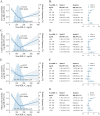Non-HDL-C and age-stratified mortality risk in the US general population: a population-based cohort study
- PMID: 40584105
- PMCID: PMC12202456
- DOI: 10.3389/fnut.2025.1591705
Non-HDL-C and age-stratified mortality risk in the US general population: a population-based cohort study
Abstract
Introduction: Non-high-density lipoprotein cholesterol (non-HDL-C) is a well-established residual causal risk factor for the progression of atherosclerotic cardiovascular disease. However, studies of large, broadly generalizable populations are lacking, and the effect of non-HDL-C on all-cause and cause-specific mortality, particularly in different age groups, remains uncertain.
Methods: We conducted a population-based cohort study using data from the National Health and Nutrition Examination Survey from 1999 to 2018. Participants were divided into six groups according to non-HDL-C levels (≤100, 101-130, 131-160, 161-190, 191-220, >220 mg/dL). Multivariable Cox proportional hazards models were used to calculate hazard ratios (HR) and corresponding 95% confidence intervals (CI). Restricted cubic spline curves and subgroup analysis were also performed to further explore the association between non-HDL-C and mortality.
Results: Of 51,252 individuals (mean age 48.1 ± 19.2 years), 7,605 (14.8%) died during follow-up. Both low and high non-HDL-C levels were significantly associated with increased risk of all-cause and cause-specific mortality, suggesting a U-shaped association. Thresholds of 156, 142, 162, and 152 mg/dL were identified for all-cause, cardiovascular, cancer, and other-cause mortality, respectively. We observed significant interactions between non-HDL-C and age for all-cause and cardiovascular mortality (P interaction<0.05 for each). The association of high non-HDL-C (>220 mg/dL) with all-cause and cardiovascular mortality was strongest in adults aged <50 years (HR, 1.51 [1.09-2.08] and 1.97 [1.07-3.12], respectively), intermediate in adults aged 50 to 69 years, and weakest in adults aged ≥70 years.
Conclusion: Non-HDL-C was U-shaped associated with all-cause and cause-specific mortality in the US general population. However, in younger adults (<50 years), the higher the non-HDL-C, the higher the risk of cardiovascular and all-cause mortality. These observations support clear public health messaging and strict adherence to primary prevention strategies for atherosclerosis in younger adults. This has important implications for the development of age-specific interventions to reduce mortality associated with non-HDL-C levels.
Keywords: NHANES data; age; cardiovascular disease; mortality; non-HDL cholesterol.
Copyright © 2025 Fu, Zhang and Li.
Conflict of interest statement
The authors declare that the research was conducted in the absence of any commercial or financial relationships that could be construed as a potential conflict of interest.
Figures



Similar articles
-
Elevated pulse wave velocity as a marker of arterial stiffness and its association with mortality in US adults.Sci Rep. 2025 Jul 2;15(1):23026. doi: 10.1038/s41598-025-07198-w. Sci Rep. 2025. PMID: 40596198 Free PMC article.
-
Effects of a gluten-reduced or gluten-free diet for the primary prevention of cardiovascular disease.Cochrane Database Syst Rev. 2022 Feb 24;2(2):CD013556. doi: 10.1002/14651858.CD013556.pub2. Cochrane Database Syst Rev. 2022. PMID: 35199850 Free PMC article.
-
Elevated remnant cholesterol and triglycerides are predictors of increased total mortality in a primary health care population of 327,347 patients.Lipids Health Dis. 2025 May 24;24(1):189. doi: 10.1186/s12944-025-02607-5. Lipids Health Dis. 2025. PMID: 40413490 Free PMC article.
-
Non-linear correlation between the ratio of high-density lipoprotein cholesterol to C-reactive protein and all-cause mortality in adults: an extensive study based on nationwide data.Popul Health Metr. 2025 Jul 1;23(1):32. doi: 10.1186/s12963-025-00396-8. Popul Health Metr. 2025. PMID: 40597306 Free PMC article.
-
Impact of residual disease as a prognostic factor for survival in women with advanced epithelial ovarian cancer after primary surgery.Cochrane Database Syst Rev. 2022 Sep 26;9(9):CD015048. doi: 10.1002/14651858.CD015048.pub2. Cochrane Database Syst Rev. 2022. PMID: 36161421 Free PMC article.
References
-
- Brunner FJ, Waldeyer C, Ojeda F, Salomaa V, Kee F, Sans S, et al. Application of non-HDL cholesterol for population-based cardiovascular risk stratification: results from the multinational cardiovascular risk consortium. Lancet. (2019) 394:2173–83. doi: 10.1016/S0140-6736(19)32519-X, PMID: - DOI - PMC - PubMed
-
- Expert Panel on Detection, Evaluation, and Treatment of High Blood Cholesterol in Adults . Executive summary of the third report of the National Cholesterol Education Program (NCEP) expert panel on detection, evaluation, and treatment of high blood cholesterol in adults (adult treatment panel III). JAMA. (2001) 285:2486–97. doi: 10.1001/jama.285.19.2486 - DOI - PubMed
LinkOut - more resources
Full Text Sources

